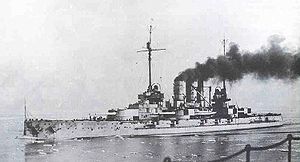SMS Ostfriesland
 SMS Ostfriesland
| |
| History | |
|---|---|
| Name | SMS Ostfriesland |
| Builder | Howaldtswerke, Kiel |
| Laid down | 19 October 1908 |
| Launched | 30 September 1909 |
| Commissioned | 1 August 1911 |
| Fate | Transferred to the US Navy |
| History | |
| Name | USS Ostfriesland |
| Commissioned | 7 April 1920 |
| Decommissioned | 20 September 1920 |
| Fate | Sunk as a target in 1921 |
| General characteristics | |
| Class and type | Helgoland-class battleship |
| Displacement | list error: <br /> list (help) 22,808 tonnes (designed) 24,700 tonnes (full load) |
| Length | 167.20 m (548.6 ft) |
| Beam | 28.50 m (94 ft) |
| Draught | 8.94 m (29.3 ft) |
| Propulsion | list error: <br /> list (help) 3 shaft 3 cylinder vertical triple-expansion steam engines 22,000 shp |
| Speed | 20.8 knots (38.5 km/h) |
| Range | 5,500 nautical miles (10,190 km) at 10 knots (19 km/h) |
| Complement | list error: <br /> list (help) 42 officers 1027 enlisted |
| Armament | list error: <br /> list (help) 12 × 12 in (305 mm) guns 14 × 150 mm (5.9 in) guns 14 × 88 mm (3.5 in) guns 6 × 500 mm (19.7 in) torpedo tubes torpedo tubes |
SMS Ostfriesland, later USS Ostfriesland as a prize of war, was a Helgoland class dreadnought battleship of the Kaiserliche Marine (German Imperial Navy). Surviving the First World War, she was sunk in an American experiment to prove the effectiveness of airpower against ships in 1920s, along with other U.S. vessels.
History
The ship was named after the German region Ostfriesland (East Frisia), which borders the Netherlands and the North Sea. Her keel was laid down on 19 October 1908 at the Imperial Dockyard at Wilhelmshaven. She was launched on 30 September 1909, and commissioned in the Imperial German Navy on 1 August 1911.
At the outbreak of the First World War, Ostfriesland was squadron flagship of the 1st Battle Squadron under Vice-Admiral Schmidt. She took part in the Raid on Scarborough, Hartlepool and Whitby on 16 December 1914 led by Rear Admiral Hipper.
In 1916 she was present at the Battle of Jutland, firing eleven 12 in (305 mm) rounds. She was undamaged by British gunfire but struck a mine on 1 June on the journey back from the battle, with 1 killed and 10 injured. Repairs were completed on 26 July 1916 at Wilhelmshaven.
Following World War I, all four Helgoland class battleships were surrendered to the Allies. On 7 April 1920 at Rosyth, Scotland, Ostfriesland was handed over to the United States Navy as “Ship H” under the command of Captain J.F. Hellweg. Under the terms of the surrender, the ship was to be destroyed by 24 July 1921.
United States service
Though in need of repairs, the ship managed to sail to New York City where she was decommissioned on 20 September 1920. She was examined extensively in dry dock at the New York Navy Yard, and returned to sea on 4 January 1921.
At the urging of Billy Mitchell, who wanted to demonstrate the power of aircraft over ships, Ostfriesland and several other ex-US (including the USS Alabama) and ex-German warships became targets for the demonstration. The smaller vessels were dispatched before the main prize, Ostfriesland, was attacked.

On the first day there were attacks by smaller bombers. Some flooding occurred and overnight Naval engineers counterflooded some compartments to level the ship, albeit lower in the water. On the second day larger bombers made attacks. Although the tests were supposed to be carefully controlled and monitored, Mitchell overrode the plans and ensured that his heaviest bombers (Handley Page O/400s)[1] from Langley Field in Virginia, attacked. The effect of some of the very heavy bombs in the water around Ostfriesland caused further flooding until she sank on 21 July 1921, about 71 miles (114 km) off the Virginia Capes.[2]
It is very unlikely the Ostfriesland could have been sunk using the aircraft technology of the time had she been underway and with damage control in operation - in fact the Ostfriesland suffered very little damage from bomb hits and the progressive flooding which sank her could have been easily managed simply by activating the ship's pumps had she had a crew aboard. Carefully edited footage of the sinking of the Ostfriesland was made public after the experimental attack and was highly influential on US Naval decision makers. [citation needed]
Pictures
-
Zeichnung der SMS Ostfriesland, 1911
-
First and second battleship squadrons and small cruisers of the German Navy, in Kiel Harbour, Germany, before the First World War
-
USS Ostfriesland - on the way to USA
Bombtests 1921
-
Bombtests, 1921
-
Hit of a 1000 kg Bomb
-
Inspection of bomb damage
-
Aerial photo
-
She is sinking
-
Ostfriesland sinking
See also
![]() Media related to SMS Ostfriesland at Wikimedia Commons
Media related to SMS Ostfriesland at Wikimedia Commons
References
- ^ Bnet. Air Classics. John Alden Reid. Bomb The Dread Noughts!
- ^ Cleary, F. J. (1921). "Relative Importance of Capital Ships And Aircraft". The Outlook. 129: 392–395. Retrieved 2009-07-30.
{{cite journal}}: Cite has empty unknown parameter:|coauthors=(help); Unknown parameter|month=ignored (help) Also see response to Cleary: Shankle, C. E. (1922). "Capital Ships And Aircraft: A Letter From Three Army Aviators". The Outlook. 130: 60–63. Retrieved 2009-07-30.{{cite journal}}: Unknown parameter|coauthors=ignored (|author=suggested) (help); Unknown parameter|month=ignored (help)








